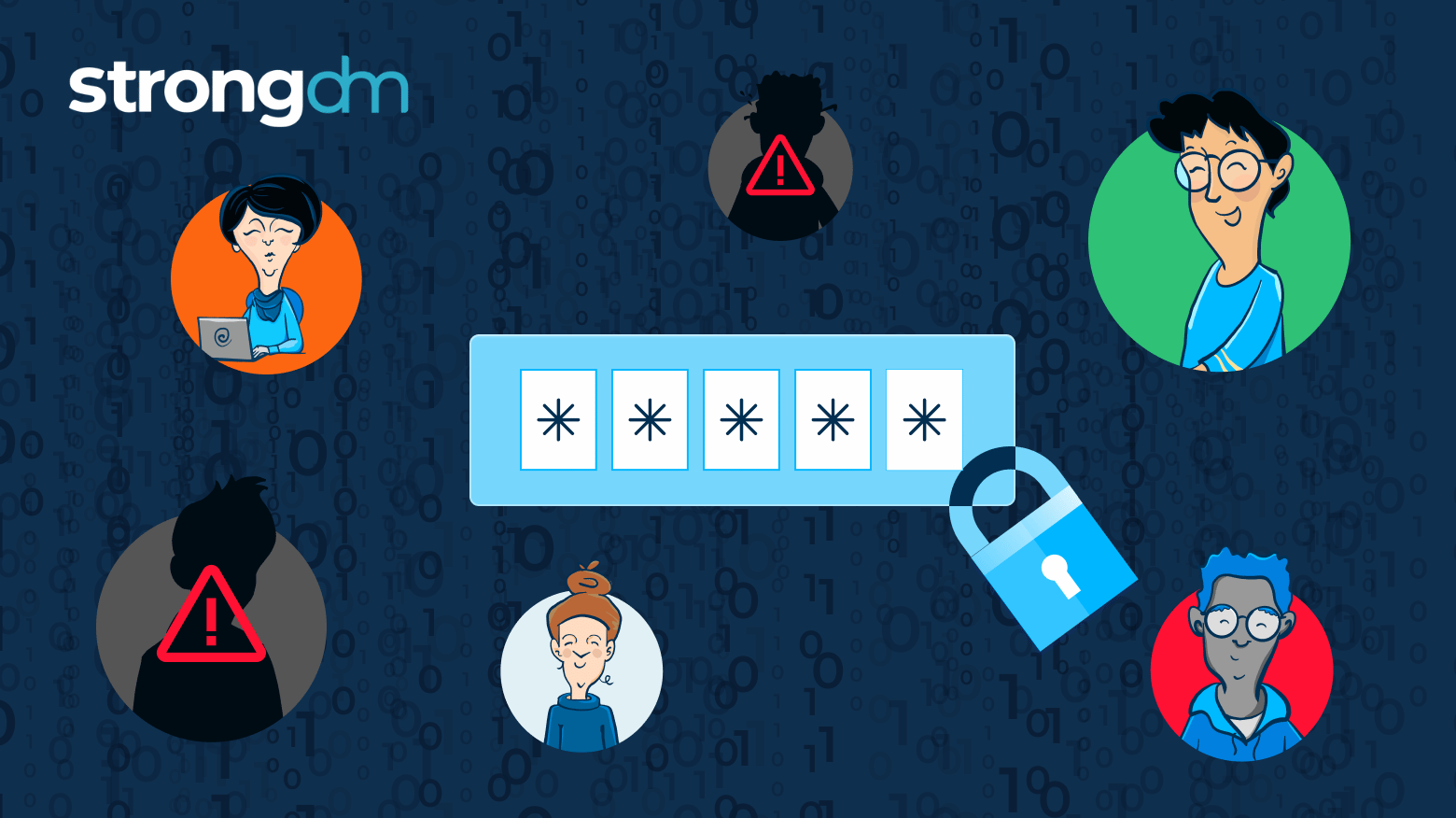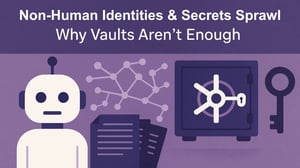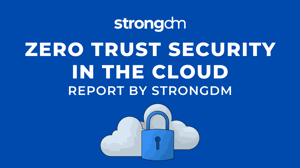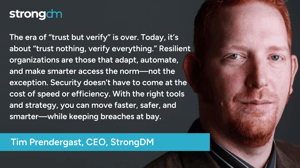
Contents
Built for Security. Loved by Devs.
- Free Trial — No Credit Card Needed
- Full Access to All Features
- Trusted by the Fortune 100, early startups, and everyone in between
There once was a time when users or devices could be deemed trustworthy once they were inside a network. They were blocked at the entrance, but after proving the validity of their access requests, they were assumed innocent until proven malicious and only had to verify their credentials. Those days are over — and they have been for some time.
The Zero Trust Architecture (ZTA) was designed in 2010 to replace antiquated castle-and-moat security models. Those models could no longer keep pace with rapidly evolving cyber attackers, so ZTA presented a paradigm shift from "trust but verify" to "never trust, always verify." It works by requiring multiple logins, allowing minimal access, and segmenting networks and applications at every feasible level.
Zero Trust Data Protection applies these tactics to sensitive data using a comprehensive cybersecurity framework, keeping your most valuable digital assets secure. We've written extensively about the composition of ZTA elsewhere, but here's a closer look at how the Zero Trust paradigm applies to data protection.
What Is Zero Trust Data Protection?
Zero Trust Data Protection is a security framework that assumes no inherent trust. It requires verification from any user attempting to access data, regardless of their location or network connection.
One distinguishing feature of Zero Trust Data Protection is that it assumes a data breach may have already occurred. It emphasizes continuous authentication and strict access controls to both mitigate cyber threats and safeguard sensitive information. Important components of Zero Trust Data Protection include:
- Access control
- Multi-factor authentication
- Microsegmentation
- The least privileged principle
- Identity and access management
- Vulnerability detection and remediation
- Continuous reporting and monitoring
Zero Trust Data Protection integrates these components into the parts of your IT environment that contain the most sensitive data. Data lakes and warehouses, databases, trade secrets, intellectual property — any mission-critical information that your operations depend on can be safeguarded by Zero Trust Data Protection.
Benefits of Zero Trust Data Protection
They say data is the new oil, and for good reason. A company's data is often its most valuable asset, so anytime a security measure can be implemented to guard it, multiple benefits follow. Some of the greatest benefits of Zero Trust data security are:
- Stronger security: Zero Trust Data Protection strengthens your security posture in multiple ways. First, it reduces your attack surface by allowing the minimum number of access requests needed for your team members to perform their tasks. Its continuous monitoring also enables faster issue detection, limiting the blast radius should an incident ever occur.
- Better compliance: When your data gets compromised, you run the risk of incurring a costly compliance violation. Zero Trust Data Protection helps you meet industry standard requirements such as HIPAA, ISO 27001, CCPA, PCI DSS, GDPR, and more.
- Greater efficiency: Zero Trust Data Protection employs automation to eliminate human error from access management processes. The result is a streamlined data security workflow with a mitigated risk of a breach.
A smaller attack surface, fewer compliance fines, more efficient access management processes — Zero Trust Data Protection doesn't just safeguard your sensitive information, it improves your business processes all around.
Components of Zero Trust Data Protection
Because an organization's cybersecurity needs can be so diverse, there's no one-size-fits-all framework specifying the exact structure of a Zero Trust Data Protection infrastructure. Despite that, there are several distinct components of a ZTA that go into many environments, including your data protection systems. The main ones are:
- Identity verification, by using strong authentication methods such as multi-factor authentication (MFA)
- Data encryption, by using cryptography to render data illegible to unauthorized parties—at rest, in use, and in transit
- Access controls, by using microsegmentation to minimize lateral movement
- Continuous monitoring, by using real-time threat detection with machine learning and behavioral analytics
- Incident response, by using automated protocols for faster vulnerability detection and remediation
Because each organization's data and infrastructure are different, the exact components of your Zero Trust Data Protection system may vary. However, companies that wish to optimize their data security should use a Zero Trust privileged access management (PAM) platform that possesses each of these functionalities.
6 Challenges of Zero Trust Data Protection
Zero Trust represents the leading edge of cybersecurity models, but it comes with its share of challenges in implementation. A Zero Trust PAM platform should be able to help you clear many of these data security hurdles, such as:
1. Complexity of implementation
Implementing Zero Trust requires a comprehensive understanding of network architecture and existing security measures. It involves configuring multiple security controls and integrating a wide number of technologies, so putting it into effect can be a tall task.
💡Make it easy: Our centralized platform unifies access management across all environments, providing seamless integration for all of Zero Trust's moving parts. This reduces complexity and greatly simplifies implementation.
2. Scalability
As organizations grow, scaling Zero Trust policies can become challenging. Maintaining your Zero Trust implementation requires consistent enforcement across an increasing number of devices, users, and applications as you scale.
💡Make it easy: StrongDM’s platform is designed for scalability, offering automated policy enforcement and dynamic access controls that grow with the organization. This ensures consistent security posture regardless of scale.
3. Real-Time monitoring and response
Continuous monitoring and rapid response to threats are crucial for Zero Trust, but implementing these capabilities can be resource-intensive and technically challenging.
💡Make it easy: Our Continuous Zero Trust Authorization offers real-time monitoring and enforcement of access policies. The result is immediate visibility and control over potential threats, as well as a faster incident response.
4. Policy management
Managing and updating access policies can be complex, particularly in dynamic environments where employees come, go, or need varying access permissions to accomplish their tasks.
💡Make it easy: Our solution simplifies policy management with centralized policy administration and automated updates. This ensures the policies are consistently applied and easily adjusted as organizational needs evolve.
5. Cost
Zero Trust implementation requires investment in new technologies, training, and ongoing maintenance —and all of those costs can add up.
💡Make it easy: Our comprehensive Zero Trust PAM platform integrates with your infrastructure and reduces the need for multiple security tools. This minimizes upfront costs and ongoing expenses associated with maintaining a robust Zero Trust environment.
6. Compliance and regulatory requirements
Meeting various regulatory standards can be challenging, particularly in industries with stringent data protection laws.
💡Make it easy: StrongDM helps organizations meet compliance requirements by providing detailed audit logs, granular access controls, and comprehensive reporting capabilities. This facilitates adherence to regulations such as GDPR, HIPAA, and others.
Although these challenges may seem daunting at first, working with a Zero Trust PAM security platform can go a long way in overcoming them all.
Zero Trust Data Protection Success Stories
To understand the benefits that Zero Trust Data Protection has to offer, it helps to look at some other organizations that have gained from its implementation. Some sample case studies are:
- A tech company looking to streamline its security processes (They said one of our competitors that they previously tried is "four to five years away from what StrongDM is doing now").
- A real estate company that pivoted from a reactive to a proactive data loss prevention system.
- A software company that implemented Zero Trust to safeguard its network as it made its workforce fully remote
Whether you're a tech company building the latest algorithms in AI or a home mortgage company helping first-time buyers find a new home, these stories all have one thing in common: Zero Trust data access made the networks secure.
Zero Trust PAM: The Future of Zero Trust Data Protection
Zero Trust Data Protection isn't just the best way to safeguard your data — given today's advanced threat landscape, it's the only way. Assuming inherent trust just because an access request is inside your network is just asking for a breach. By implementing the latest tactics in authentication, network segmentation, encryption, access controls, and continuous monitoring, Zero Trust data security takes the opposite approach.
At StrongDM, our Zero Trust PAM platform is complete with all the functionalities needed to help you make the switch to a Zero Trust model. Contact us today to book a demo and see how it works.
Next Steps
StrongDM unifies access management across databases, servers, clusters, and more—for IT, security, and DevOps teams.
- Learn how StrongDM works
- Book a personalized demo
- Start your free StrongDM trial

Categories:

About the Author
Michaline Todd, Marketing Expert, is a distinguished marketing leader with a track record spanning over two decades in the software industry. With tenure of over 10 years as a Chief Marketing Officer, she has left an indelible mark on companies such as Oracle, Veritas, MarkLogic, Evident.io, Palo Alto Networks, and StrongDM. Michaline's expertise lies at the intersection of technology and marketing, driving strategic initiatives that fuel business growth and innovation.
You May Also Like




